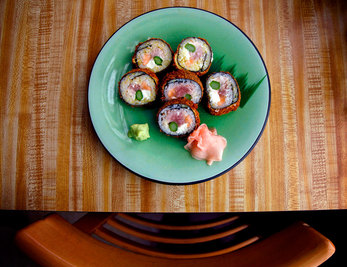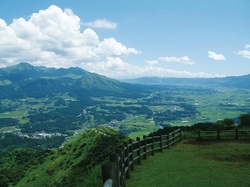
Captain Crunch Roll at Japanese Restaurant "Kyushu" in Virginia
I was having some issues with how to really channel my research in the right direction, especially since there weren't really as many sources as I had hoped for. After presenting to the class and getting some feed back on the project so far, I've altered my research topic a little.
Though I'd like to leave Kyushu as the main focus, I'd also like to in incorporate other areas of Japan, to use as a comparison. This way, I can expand geographically, spend less time on the extensive history of one specific area and look deeper into the actual foodways of that area.
Another idea I'd like to touch on is the "imaged community" of Kyushu, which was also a suggestion from the class. I like this idea, because I think my original research topic was in some way the product of me getting sucked off into this imagined Kyushu (oh so beautiful and lush and traditional and etc...). In looking for sources I seemed to find phrases and hints of people referring to Kyushu as "Old Japan" and "nostalgic", but so far I haven't really been able to find anything more solid than that. So I've browsed the internet and found several sources that provide a shred of information, usually just support of this vague idea of "Southern/Nostalgic/Old Kyushu". Hopefully I can find more substantial information. Also, I will be working on gathering more information on Tokyo, a city that I think contrasts with the image of the deep South of Japan, and I'm thinking of looking towards Hokkaido, since it is the Northern most island of Japan and it is similar to Kyushu in the way that it has the aspect of "tradition" because of the Ainu people (but also the home of the "Western" practice of dairy production that has changed Japan).
Hopefully I can find a couple foods (whether it is an ingredient or an actual dish) from each of these areas to focus in on even more (which was also another suggestion).
An interesting thing is that there is a Japanese restaurant in Virgina called Kyushu and I saw that one of their dishes is called "Captain Crunch Roll" which is basically fish, asparagus, cream cheese in a roll - ALL FRIED. It looks yumm
Here are some sources I've browsed through so far:
Kyushu as Old Japan/ Deep south etc...
Though I'd like to leave Kyushu as the main focus, I'd also like to in incorporate other areas of Japan, to use as a comparison. This way, I can expand geographically, spend less time on the extensive history of one specific area and look deeper into the actual foodways of that area.
Another idea I'd like to touch on is the "imaged community" of Kyushu, which was also a suggestion from the class. I like this idea, because I think my original research topic was in some way the product of me getting sucked off into this imagined Kyushu (oh so beautiful and lush and traditional and etc...). In looking for sources I seemed to find phrases and hints of people referring to Kyushu as "Old Japan" and "nostalgic", but so far I haven't really been able to find anything more solid than that. So I've browsed the internet and found several sources that provide a shred of information, usually just support of this vague idea of "Southern/Nostalgic/Old Kyushu". Hopefully I can find more substantial information. Also, I will be working on gathering more information on Tokyo, a city that I think contrasts with the image of the deep South of Japan, and I'm thinking of looking towards Hokkaido, since it is the Northern most island of Japan and it is similar to Kyushu in the way that it has the aspect of "tradition" because of the Ainu people (but also the home of the "Western" practice of dairy production that has changed Japan).
Hopefully I can find a couple foods (whether it is an ingredient or an actual dish) from each of these areas to focus in on even more (which was also another suggestion).
An interesting thing is that there is a Japanese restaurant in Virgina called Kyushu and I saw that one of their dishes is called "Captain Crunch Roll" which is basically fish, asparagus, cream cheese in a roll - ALL FRIED. It looks yumm
Here are some sources I've browsed through so far:
Kyushu as Old Japan/ Deep south etc...
- (ramen tonkotsu in tokyo) http://whiteonricecouple.com/travel/tonkotsu-kyushu-ramen/
- (famous chef makes kyushu fried chicken) http://www.japanesefoodreport.com/2008/05/kyushu-style-fried-chicken.html
- (Japan for Inside Japan Centre) http://blog.japancentre.com/2012/07/09/jaff-japan-centres-third-japan-food-festival-27th-july-12th-august/
- Kyushu self promotion - http://www.welcomekyushu.com/area/kumamoto.html
- Kyushu shinkansen: http://www.shifteast.com/new-kyushu-shinkansen-targets-rural-nostalgia/
- Kyushu Tokyo comparison:http://books.google.com/books?id=iz06xSmiDqMC&pg=PA106&lpg=PA106&dq=Kyushu+and+Tokyo+regional+differences&source=bl&ots=7Zz_rsmNMk&sig=WcYusIg_4VotIUdGV7TCsZfzqpw&hl=en&sa=X&ei=3-6JUMytGon10gHQm4GgCg&ved=0CDYQ6AEwAw#v=onepage&q=Kyushu%20and%20Tokyo%20regional%20differences&f=false
- Geography of Japan: http://wiki.answers.com/Q/What_are_the_five_themes_of_the_geography_of_Japan
- Agriculture in Japan: http://factsanddetails.com/japan.php?itemid=941#02
- Kyushu geography/trade: http://www.jcie.org/researchpdfs/Kyushu/KyushuReport.pdf
- Kyushu Restaurant in Virgina: http://www.kyushujap.com/
- Urban area/rural: http://books.google.com/books?id=Bpxo8MxGqUkC&pg=PA129&lpg=PA129&dq=tokyo+foodways&source=bl&ots=2mSdG8rpR8&sig=6d0DmgfwreVXx0CpnffZ2fIguh4&hl=en&sa=X&ei=XeqKUJXAOs_J0AGRtIGADA&ved=0CCQQ6AEwAQ#v=onepage&q=kyushu&f=false
- food history: http://www.cambridge.org/us/books/kiple/japan.htm
- World Food Japan (lonely planet guide) http://www.amazon.com/gp/reader/1740590104/ref=sr_1_1?p=S00Y&keywords=Kyushu&ie=UTF8&qid=1351342726
- Kyushu “profile” (silicon island): http://www.kyukeiren.or.jp/english/profile/industrymaking.html
- Hokkaido, unique food culture: http://www.kikkoman.com/foodforum/thejapanesetable/10.shtml
- Hokkaido specific foods (connect city to countryside):http://www.nihonsun.com/2009/01/02/regional-foods-in-japan-hokkaido/
- Ainu Food culture (Traditional food systems of Indeginous Poeple: The Ainu in the Saru RIver Region, Japan): ftp://ftp.fao.org/docrep/fao/012/i0370e/i0370e08.pdf
- Tokyo restaurants guide blog: http://tokyofoodie.com/category/cuisines/african/

 RSS Feed
RSS Feed